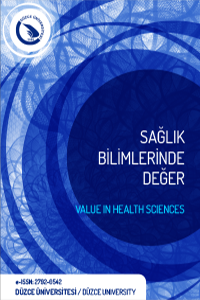Düzce Üniversitesi Tıp Fakültesi 4-5-6. Sınıf Öğrenci Memnuniyeti Düzeyi Değerlendirilmesi
Öğrenci memnuniyeti ölçeği; tıp eğitimi; klinik bilimler; yükseköğrenim
-
___
- YÖDEK, Yükseköğretim Kurumlarında Akademik Değerlendirme ve Kalite Geliştirme Yönetmeliği. Resmi Gazete. 28 Aralık 2006; Sayı: 26390.
- Düzce Üniversitesi Stratejik Planı, 2010-2014. Düzce: Düzce Üniversitesi; 2009. 80.
- Düzce Tıp Fakültesi 4., 5. ve 6. Sınıf Öğrencilerinin Memnuniyeti Araştırma Raporu. Düzce: Düzce Üniversitesi, 2009-2010.
- Aldridge S, Rowley J. Measuring costomer satisfaction in higher education. Quality Assurance in Education. 1998; 6(4): 197-20
- Martensen A, Grİnholdt L, Eskildsen J, Kristensen K. Measuring student oriented quality in higher education: application of the ECSI methodology//Proceedings from the TQM for Higher Education conference. Verona: Higher Education institutions and the issue of total quality; 2000. p. 371-38
- Okçu V. Eğitimde Toplam Kalite Yönetiminin Uygulaması. Milli Eğitim. 2008; 179; 283-92.
- Kogan JR, Shea JA. Course Evaluation in medical education. Teaching and Teacher Education. 2007; 23: 251-64.
- Epi-InfoTM, Statistic Package Program Version 3.3.2; 2005. Available from: http://www.cdc.gov/EPIINFO/epiinfo.htm. KOÜTF Üniversitesi Tıp Fakültesi Öğrenci Memnuniyeti Araştırması Raporu. Kocaeli: Kocaeli Üniversitesi; 2010. s.1
- Yükseköğretim kurumlarında akademik değerlendirme ve kalite geliştirme rehberi, Sürüm: 2007/1.1. Ankara: Yödek; Nisan 2007.
- Yükseköğretim akademik değerlendirme ve kalite geliştirme komisyonu. Ankara: Yödek; Nisan 2007. s. 49.
- Ziaee V, Ahmedinejat Z, Morravejdi AR. An Evaluation on Medical Students' Satisfaction with Clinical Education and its Effective Factors. Med Educ Online [serial online]. 2004; 9: KOÜTF Üniversitesi Tıp Fakültesi Görev Tanımı Yönergesi. Kocaeli: Kocaeli Üniversitesi; 2010.
- Kanjı GK, Tambi AM. Total Quality management in UK higher education institutions. Total Quality Management. 1999; 10(1): 129-53.
- Yayın Aralığı: Yılda 3 Sayı
- Başlangıç: 2022
- Yayıncı: Düzce Üniversitesi
Bora BÜKEN, Erhan BÜKEN, Ferhan KANDEMİR
Anestezi Şeklinin (Genel ve Lokal), Sezaryen Sonuçlarına Etkisi ve Karşılaştırılması
Simender MESCİ HAFTACI, Engin HAFTACI
Emel ÇALIŞKAN, Cihadiye ÖZTÜRK, İdris ŞAHİN
Bilateral Avasküler Nekroz Zemininde Total Kalça Yüzey Değiştirme Artroplastisi: Bir Olgu Sunumu
Zafer ORHAN, Kazım SOLAK, Zekeriya KARADUMAN
Düzce Üniversitesi Tıp Fakültesi 4-5-6. Sınıf Öğrenci Memnuniyeti Düzeyi Değerlendirilmesi
Nuray YEŞİLDAL ÇELEBİLER, Büşra SÜZEN, Refika ŞENDAĞ, Abdülcebbar ŞİPAL, Elif S. TAMSES, Yasin TATOĞLU, Ayşe N. TEMİR, Gül TEZCAN
